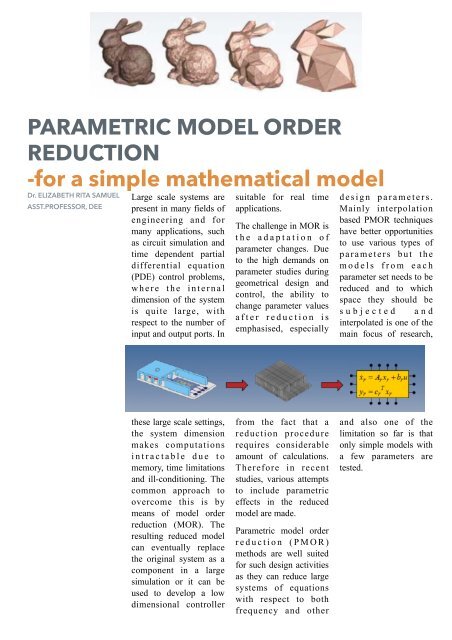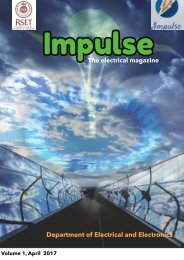combinepdf
You also want an ePaper? Increase the reach of your titles
YUMPU automatically turns print PDFs into web optimized ePapers that Google loves.
capabilities, they can let<br />
grid operators monitor<br />
and control them in<br />
response to changing<br />
conditions.<br />
paired, or coupled, their<br />
motions will naturally<br />
align and picture several<br />
weights hanging from<br />
springs that are connected<br />
to a rigid and fixed board.<br />
g r i d f r e q u e n c y w i l l<br />
s i m i l a r l y c a u s e t h e<br />
inverter to adjust its<br />
p o w e r o u t p u t t o<br />
compensate. The use of<br />
“Electric Springs” is a<br />
voltage instability and<br />
frequency deviations. In<br />
recent years, Electric<br />
Springs (ESs) have been<br />
developed as a new<br />
means of addressing these<br />
issues. Besides regulating<br />
a c v o l t a g e s i n t h e<br />
distribution network, ESs<br />
can also regulate the load<br />
power flow to response<br />
the variable renewable<br />
sources. Therefore, it<br />
brings a new control<br />
paradigm, i.e., the load<br />
d e m a n d f o l l o w i n g<br />
v a r i a b l e p o w e r<br />
generation.<br />
The power grids of the<br />
future may need advanced<br />
inverters that don’t simply<br />
follow what the grid is<br />
doing but actually help<br />
f o r m t h e g r i d , b y<br />
r e s p o n d i n g<br />
i n s t a n t a n e o u s l y t o<br />
disturbances and working<br />
in concert to help keep the<br />
g r i d s t a b l e . T h i s<br />
approach, known as<br />
Virtual Oscillator Control<br />
(VOC), was developed by<br />
an NREL team led by<br />
Brian Johnson working<br />
with Sairaj Dhople of the<br />
University of Minnesota;<br />
Francesco Bullo at the<br />
University of California,<br />
S a n t a B a r b a r a ; a n d<br />
Florian Dörfler at ETH<br />
Zurich.<br />
The basic idea behind<br />
VOC is to leverage the<br />
properties of oscillators—<br />
that is, anything that<br />
moves in a periodic<br />
f a s h i o n , s u c h a s a<br />
mechanical spring, a<br />
metronome, or a motor.<br />
When two oscillators are<br />
As the weights are given a<br />
pull to set the springs<br />
bouncing, the springs will<br />
tend to bounce in an<br />
uncoordinated fashion.<br />
However, if the board<br />
itself is suspended from<br />
the ceiling on springs, it<br />
becomes a feedback<br />
mechanism that responds<br />
inversely to the pushes<br />
a n d p u l l s f r o m t h e<br />
bouncing weights. Within<br />
a short period of time, the<br />
weights will all start<br />
bouncing at the same<br />
frequency, all in lockstep.<br />
For virtual oscillator<br />
control, the trick is to<br />
m a k e e a c h i n v e r t e r<br />
respond to the grid much<br />
like a spring: If the grid<br />
voltage drops, the inverter<br />
adjusts its output such<br />
that it “pushes” against<br />
the voltage change.<br />
Likewise, a surge in grid<br />
voltage will induce an<br />
inverter to “pull” the<br />
voltage back to the<br />
n o m i n a l r a n g e . A n<br />
increase or decrease in<br />
novel way of distributed<br />
voltage control while<br />
simultaneously achieving<br />
effective Demand-Side<br />
M a n a g e m e n t ( D S M )<br />
through modulation of<br />
noncritical loads in<br />
r e s p o n s e t o t h e<br />
f l u c t u a t i o n s i n<br />
intermittent renewable<br />
energy sources like Wind,<br />
solar etc. The role of<br />
demand side management<br />
is going to be critical once<br />
t h e p e n e t r a t i o n o f<br />
renewable energy sources<br />
becomes significant. This<br />
would bring about a<br />
paradigm shift from the<br />
traditional centralised<br />
control of hundreds of<br />
power plants to match the<br />
demand to decentralised<br />
control of millions of<br />
loads to balance the<br />
supply (generation). In a<br />
distribution network,<br />
uncertainty and variability<br />
associated with renewable<br />
energy sources, such as<br />
solar power and wind<br />
power, can easily cause<br />
p o w e r f l u c t u a t i o n s ,<br />
An ES connected in series<br />
with the noncritical load<br />
(e.g., a water heater) that<br />
has high voltage variation<br />
tolerance forms the socalled<br />
smart load. The<br />
critical load that requires<br />
a well-regulated mains<br />
voltage is parallel with<br />
the smart load branch. By<br />
operating under inductive<br />
or capacitive mode, the<br />
E S c a n i n j e c t a<br />
controllable voltage and<br />
accordingly change the<br />
uncritical load voltage so<br />
as to maintain the voltage<br />
across the smart load at a<br />
c o n s t a n t l e v e l . I n<br />
addition, it also enables<br />
uncritical load to vary its<br />
power consumption and<br />
thus contributes to the<br />
d e m a n d r e s p o n s e .<br />
Overall, the smart load<br />
c a n b e i n t e n d e d t o<br />
provide reactive power<br />
compensation to the<br />
system by adjusting the<br />
output voltage of ES and<br />
ensure a tightly regulated<br />
voltage across the critical<br />
load.




